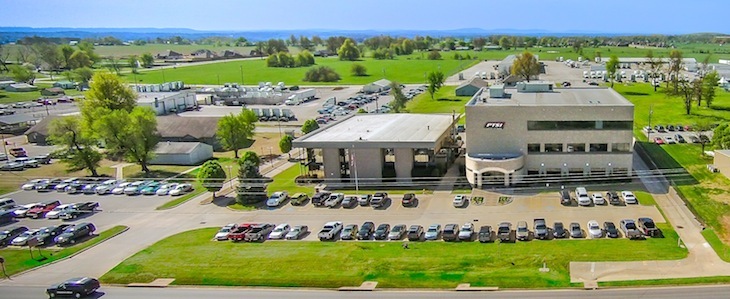P.A.M. reports 2nd loss of year; revenue decreased in second quarter
by July 23, 2020 7:02 pm 395 views

P.A.M. Transportation headquarters in Tontitown, Ark.
Tontitown-based carrier P.A.M. Transportation Services Inc. reported a second consecutive loss in 2020 as revenue fell in the second quarter amidst the COVID-19 pandemic.
Before the markets closed Thursday (July 23), P.A.M. announced an $823,000 loss, or a loss of 14 cents per share, in the second quarter, compared to net income of $8.65 million, or $1.45 per share, in the same period in 2019. Revenue declined 30.1% to $92.97 million, from $133 million.
Through the first half of 2020, the carrier reported a loss of $2.12 million, or a loss of 37 cents per share, compared to net income of $16.95 million, or $2.84 per share, in the same period in 2019. Revenue declined 15.1% to $222.13 million, from $261.68 million.
In the second quarter, revenue for the carrier’s logistics operations fell 18.8% to $15.8 million, from $19.48 million. Through the first half of the year, the revenue has fallen 8.7% to $36.31 million, from $39.81 million.
Revenue per truck per day declined to $540 in the second quarter, from $703 in the same period in 2019. The number of company truck drivers increased to 1,562, from 1,520, while the number of owner-operators fell to 462, from 545.
“Our second-quarter results reflect the significant financial impact of the temporary winding down of operations by our three largest manufacturing customers in response to COVID-19, with April and May bearing the brunt of that impact with a combined operating loss of $4.6 million during those two months,” said Allen West, chief financial officer. “We returned to more normalized levels of profitability during June as automotive manufacturing plants resumed production.”
The automotive industry comprised about 45% of the carrier’s revenue before the virus, and with the uncertainty of when the plants would restart, the carrier was “forced to aggressively redeploy our trucks to secure replacement revenue to keep our drivers engaged and intact,” West said. “Replacement revenue, often from a depressed spot market, offered lower rates and required more empty miles between delivery and subsequent reloading. These factors contributed to reductions in rates and truck productivity while increasing uncompensated miles.”
Another issue over the second quarter was the freight that was loaded into the carrier’s trailers but couldn’t be delivered as a result of receivers being shut down because of COVID, said West, adding that this removed these trailers’ availability.
In early June, automotive plants restarted but were not operating at full capacity initially. As a result, the carrier started to operate again in its existing network but on a smaller scale. This also allowed the carrier to deliver freight that had been in its trailers for weeks.
The carrier’s Mexico business “relies heavily” on the automotive industry, West said, and “the number of border crossings suffered as a result of the automotive closings. While we did expand our cross-border customer base during the second quarter, this additional business did not emerge fast enough to fill the void of lost automotive revenues experienced earlier in the quarter. However, in conjunction with the return of automotive business, we expect that this expanded customer base will yield positive results in future periods by contributing to our growth goals in our cross-border business unit.”
Transborder freight between the United States and Canada and Mexico fell 48.9% to $56.1 billion in May, from the same month in 2019, and was the lowest level since May 2009, according to the Bureau of Transportation Statistics. Trucks moved $39.1 billion of the freight, down 43.2% from May 2019. Vehicles and parts comprised the third largest truck commodity at $2.2 billion, behind computers and parts ($7.5 billion) and electrical machinery ($5.6 billion).
In April and May, P.A.M. cut costs, including furloughing employees and laying off others, West said.
“With the return of automotive production, the increase in general economic activity as we approached the end of the second quarter, and cost reductions recently implemented which have yet to be fully realized, we believe that we are well-positioned for a strong recovery as the remainder of the year progresses,” he noted.
P.A.M. President and CEO Daniel Cushman retired May 1 and will remain a company adviser through July 31. Matthew T. Moroun, chairman of the company’s board of directors, will serve as interim president and CEO until a replacement is named. Moroun owns 68% of the company’s shares, according to the company’s proxy filing.
Shares of P.A.M. (NASDAQ: PTSI) closed Thursday at $32.36, down 74 cents, or 2.2%. In the past 52 weeks, the stock has ranged from $71.56 and $22.
